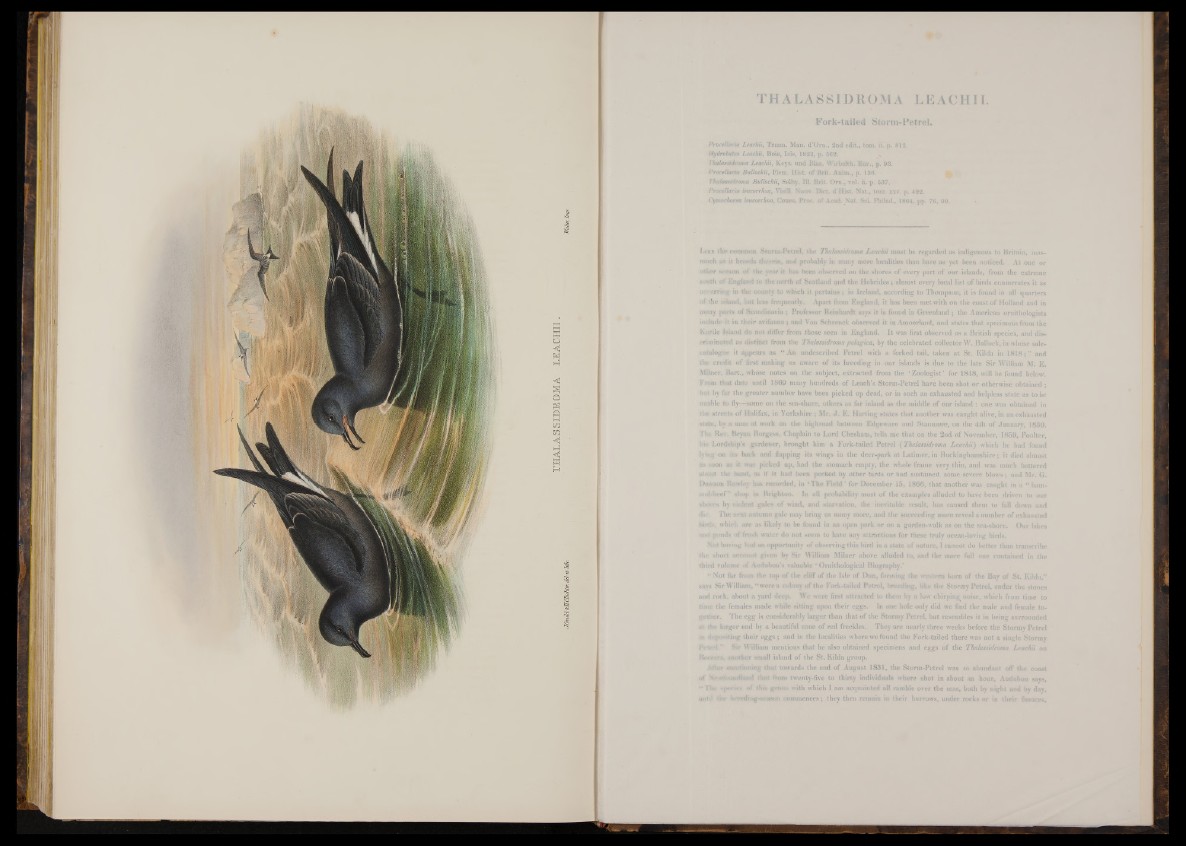
Fork-tailed Storm-Petrel.
Procellaria LeachH, Teram. Man. d’Orn., 2nd edit., tom. ii. p. 812.
Hydrohatet Leachii, Boie, Isis, 1822, p. 562.
Thalatndroma Leachii, Keys, und Bias. Wirbelth. Kur., p. 98.
Procellaria Bullockii, Flem. I-Iist. of Brit. Anitn., p. 13(5.
Thalossidroma Bullockii, Selby, 111. Brit. Orn., vol. ii. p. 537.
Procellaria leucorrhoa, VieiH. Nouv. Diet. d'Hist. Nat., tom. xxv. p. 422.
Cymochorea leucorrhoa, Cones. Prof. of Acad. Nat. Sci. Phi lad., 1864, pp. 76, 90.
JdKE the common Storm-Petrel, the Thalossidroma Leachii must be regarded as indigenous to Britain, inasmuch
m it breeds therein, and probably in many more localities tban have as yet been noticed. At one or
other season o f the year it has been observed on the shores of every part o f our islands, from the extreme
south of England to the north o f Scotland and the Hebrides ; almost every local list o f birds enumerates it as
otV'iirriwg in the county to which it pertains ; in Ireland, according to Thompson, it is found in all quarters
of the island, but less frequently. Apart from England, it has been met with on the coast of Holland and in
nasey parts o f Scandinavia ; Professor Reinhardt says it is found in Greenland ; the American ornithologists
include it in their avifauna ; and Von Schrenek observed it in Amoorland, and states that specimens from the
Korile Island do not differ from those seen in England. It was first observed as a British species, and discriminated
as distinct from the Thalossidroma pelágica, by the celebrated collector W. Bullock, in whose sale-
catalogue it is;.-pears as “ An undescribed Petrel with a forked tail, taken at St. Kilda in 1 8 1 8 ;” and
the credit o f first making us aware o f its breeding in our islands is due to the late Sir William M. E.
Milner, Bart., whose notes on the subject, extracted from the ‘Zoologist’ for 1848, will he found below;
From that date until 1869 many hundreds o f Leach’s Storm-Petrel have been shot or otherwise obtained ;
hut by &r the greater number have been picked up dead, or in such an exhausted and helpless state as to be
««able to fly—-some on thé sea-shore, others as far inland as the middle of our island : one was obtained in
lit* streets o f Halifax, in Yorkshire ; Mr. .1. E. Harting states that another was caught alive, in an exhausted
stale, by a man at work on the highroad between Edgeware and Stanmore, on the 4th of January, 1850.
The Res. Bryan Burgess, Chaplain to Lord Chesham, tells me that on the 2nd o f November, 1859, Poulter,
hi* Lordship's gardener, brought him a Fork-tailed Petrel ( Thalossidroma Leachii') which he had found
lyiiig on sis back and flapping its wings in the deer-park at Latimer, in Buckinghamshire ; it died almost
sis soon as it was picked up, had the stomach empty, the whole frame very thin, and was much battered
aboMit the head, as if it had been pecked by other birds or bad sustained some severe blows ; and Mr. G.
Dawson Rowley has recorded, in ‘The Field5 for December 15, 1866, that another was caught in a “ ham-
aittMteef” shop in Brighton. In all probability most o f the examples alluded to have been driven to our
shores by violent gales of wind, and starvation, the inevitable result, has caused them to fall down and
die The next autumn gale may bring us many more, and the succeeding morn reveal a number of exhausted
bird*, which are as likely to be found in an open park or on a garden-walk as on the sea-shore. Our lakes
and ponds of fresh water do not seem to have any attractions for these truly ocean-loving birds.
Not having bad an opportunity o f observing this bird in a state o f nature, I cannot do better than transcribe
the short accownt given by Sir William Milner above alluded to, and the more full one contained in the
third volume of Audubon’s valuable ‘ Ornithological Biography.’
“ Not far from the top o f the cliff of the Isle o f Dun, forming the western horn o f the Bay of St. Kilda,”
says Sir William, “ were a colony o f the Fork-tailed Petrel, breeding, like the Stormy Petrel, under the stones
and rock, about a yard deep. We were first attracted to them by a low chirping noise, which from time to
time the females made while sitting upon their eggs. In one hole only did we find the male and female together.
The egg is considerably larger than that o f the Stormy Petrel, but resembles it in being surrounded
*t the larger end by a beautiful zone o f red freckles. They are nearly three weeks before the Stormy Petrel
w depositing their eggs ; and in the localities where we found the Fork-tailed there was not a single Stormy
P ew l " Sir William mentions that he also obtained specimens and eggs o f the Thalossidroma Leachii on
Bo; . another small island o f the St. Kilda group.
After mentioning that towards the end o f August 1831, the Storm-Petrel was so abundant off the coast
rtf that from twenty-five to thirty individuals where shot in about an hour, Audubon says,
“ The aperies o f this genus with which I am acquainted all ramble over the seas, both by night and by day,
until the hrcediug-seasun commences ; they then remain in their burrows, under rocks or in their fissures,